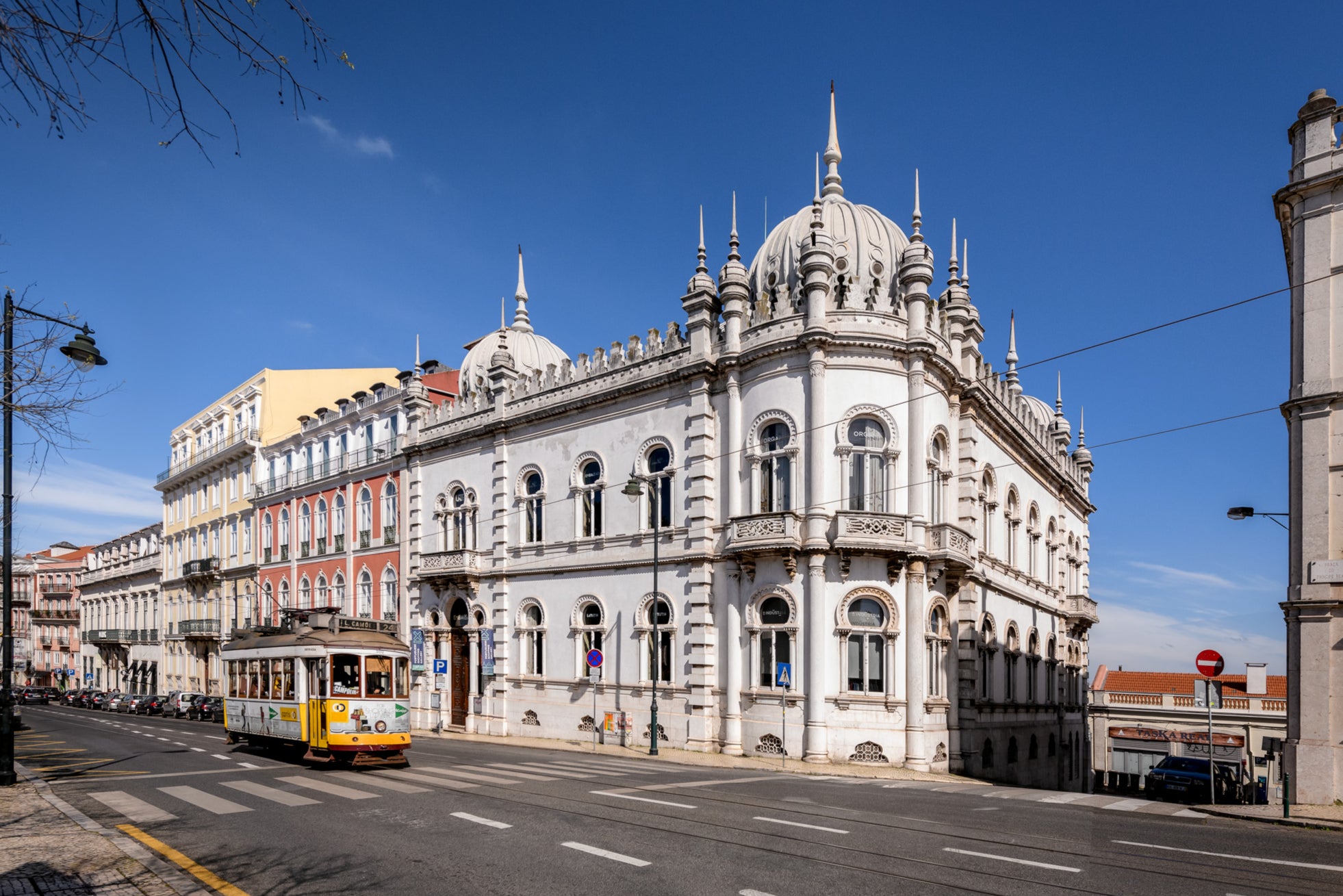Situated among hills and the river Tagus, Lisbon is a not too big of a city with plenty to see and do. Here you will find suggestions for things to do, places to eat and accommodation for your stay.

What to do?
You will find
miradouros situated all over the most central parts of Lisbon. These viewpoints, situated on high spots on the hills of Lisbon, are like one big public balcony for those living and visiting the city. Here you will find a list of some of our favourites, but be sure to explore more of them.
- Portas do Sol - Largo Portas do Sol, 1100-411 Lisboa, Portugal
- Montes Claros - Estr. Montes Claros, Lisboa, Portugal
- São Pedro de Alcântara - R. de São Pedro de Alcântara, 1200-470 Lisboa, Portugal
- Monte Agudo - PC Novas Nações 42, 1170-175 Lisboa, Portugal
- Jardim do Torel - R. Júlio de Andrade, 1150-122 Lisboa, Portugal

Miradouro Portas do Sol
The Lisbon Oceanarium has a large collection of marine species — penguins, seagulls and other birds; sea otters (mammals); sharks, rays, chimaeras, seahorses and other bony fish; crustaceans; starfish, sea urchins and other echinoderms; sea anemones, corals and other cnidaria; octopuses, cuttlefish, sea snails and other mollusks; amphibians; jellyfish; marine plants and terrestrial plants and other marine organisms totaling about 16,000 individuals of 450 species.
The main exhibit is a 1,000 m2, 5,000,000 L tank with four large 49 m2 acrylic windows on its sides. It is 7 m deep, which provides the illusion of the open ocean. About 100 species from around the world are kept in this tank, including sharks, rays, barracudas, groupers, and moray eels. One of the main attractions is a large sunfish.

Oceanário de Lisboa
São Jorge Castle, sometimes known in English as Saint George s Castle, is a historic castle in the Portuguese capital of Lisbon. Human occupation of the castle hill dates to at least the 8th century BC while the oldest fortifications on the site date from the 2nd century BC. The hill on which Saint George s Castle stands has played an important part in the history of Lisbon, having served as the location of fortifications occupied successively by Phoenicians, Carthaginians, Romans, and Moors, before its conquest by the Portuguese in the 1147 Siege of Lisbon. Since the 12th century, the castle has variously served as a royal palace, a military barracks, home of the Torre do Tombo National Archive, and now as a national monument and museum.

Castelo de São Jorge
Belém is famous as a museum district, as the home of many of the most notable monuments of Lisbon and Portugal alike, such as the Belém Tower, the Jerónimos Monastery, the Padrão dos Descobrimentos, and Belém Palace (official residence of the President of Portugal). It´s also home to one of the best kept
secrets that every one knows about - the pastel de Belem, a version of the typical pastel de nata that you´ll have you queueing a second time to buy more!
 Padrão dos Descobrimentos and Mosteiro dos Jerónimos in Belém Padrão dos Descobrimentos and Mosteiro dos Jerónimos in Belém |
 Pastéis de Belem Pastéis de Belem |
Where to eat?
Where not to eat? Lisbon is full of good food, which I´m sure you´ve heard Tobias boast about. Here you will find suggestions within various of types of restaurants you might find in the city.
Frango Assado
Grilled chicken is NOT a restaurant, but more of a lifestyle. The Portuguese will eat grilled chicken more often than Norwegians eat taco. It is a cheap, no frill or fuss affair, consisting of delicious grilled chicken, rice, fries and salad (yes, you must have two types of carbs). Have it with some piri-piri sauce if you dare.
- Primavera (Our local chicken shop, and our favourite) - R. Morais Soares 101, 1170-293 Lisboa, Portugal
- Rio de Mel (Just take away, but considered by many as THE BEST™) - Av. da Igreja 25D, 1700-266 Lisboa, Portugal
- A Valenciana - Rua Marquês de Fronteira 157 163A, 1070-294 Lisboa, Portugal
Tascas
Tascas are cantine-like restaurants, in the sense than everyone and their uncle has lunch there. They serve typical portuguese food you would get at your grandma´s and usually at a quite affordable price. These typical restaurants usual have a set menu and daily specials. Be sure to drown it in some house wine (not too good, but it will do the job) or a nice cold Imperial (tap beer, Lisbon style)
- Tico-Tico - Av. Rio de Janeiro 19, 1700-330 Lisboa, Portugal
- Adega das Gravatas - Tv. Pregoeiro 15, 1600-588 Lisboa, Portugal
- Adega Solar Minhoto - Av. Rio de Janeiro 29F, 1700-111 Lisboa, Portugal
- Os Courenses - R. José Duro 27D, 1700-272 Lisboa, Portugal
Marisco
Seafood is absolutely fantastic in Lisbon, and we have some big house names to choose from. Whether you are more of a fish person, or a straight up lobster person, you will find that Portuguese seafood places do not disappoint, if you know where to go.
- Ramiro - By far the most known, excellent food but the queues can be a nightmare... be sure to go early or book in advance. - Av. Alm. Reis 1 H, 1150-007 Lisboa, Portugal
- Sete Mares - Definitely a local name, this seafood place has all you need and more! Has a good offer of other traditional food as well, but we usually go for the lavagante (type of lobster). - Av. Columbano Bordalo Pinheiro 108, Lisboa, Portugal
- Nunes Real Marisqueira - The most luxurious of the three. Expect a magnificent dinner and a seafood rice advertised for two that is enough for 4 people. The best spider crab pate in the land! - R. Bartolomeu Dias 172 E F, 1400-031 Lisboa, Portugal
Fado clubs
This suggestion is not so much about the food but much more about the music! Fado is a music genre which can be traced to the 1820s in Lisbon, Portugal but probably has much earlier origins. Although the origins are difficult to trace, today fado is commonly regarded as simply a form of song which can be about anything, but must follow a certain traditional structure. In popular belief, fado is a form of music characterized by mournful tunes and lyrics, often about the sea or the life of the poor, and infused with a sense of resignation, fate and melancholy. In Lisbon you can find various clubs and restaurants where you can sit and listen to live music while enjoying a light meal and some wine.
- Fado na Morgadinha - Lgo Peneireiro 5, 1100-435 Lisboa, Portugal
- Clube de Fado - R. de São João da Praça 94, 1100-521 Lisboa, Portugal
the best of the best pastel de nata in Lisbon, according to us.
Ask anyone, they will have their own opinion of which one is the best Pastel of all... some say Pastel de Belém (only sold in Belém at their café/factory) is on its own category, I disagree. That being said, THE BEST™ pastel de nata, according to the bride and groom is the one from
Manteigaria, that has various locations in Lisbon. Go there to get the cake and a show (they have an open kitchen where you can see them being made) or get them delivered to where you staying and enjoy a delicious and not very nutritious breakfast.
Where to stay?
Visiting Lisbon in February has the advantage of better prices and greater offer. There are many hotels to choose from, so go ahead and explore. Here you will find a list with a few hotels we can recommend, as well as a list of areas that would be nicer to stay at in the city - from there you can look up airbnb´s or other rental options you might find.
AirBnB
AirBnB is very popular in Portugal, Lisbon being one of the places where the offer is greatest. There are various levels and price ranges you can find, but some options might even be better then staying at a hotel. Make sure to check the reviews ;)
We recommend you stay within the more central neighbourhoods of Lisbon, such as:
- Graça - On the path of many viewpoints, you stay where many true Lisbonites still live at.
-

- Alfama - one of Lisbon’s oldest areas. Passengers pack the historic no. 28 tram, which winds through Alfama on its way up to 11th-century São Jorge Castle. In the evening, melancholy Fado music can be heard in some of the area´s long-running restaurants.
-

- Avenidas Novas - As Lisbon grew in the mid-20th century, it expanded north, away from the waterfront. Residential and business districts were born around long, broad avenues, today collectively known as Avenidas Novas (New Avenues). While it may lack historic sights, this part of town still attracts quite a number of tourists, as it’s home to many hotels and to one of the city´s best museums (the must-see Calouste Gulbenkian Museum).
-

- Principe Real - Príncipe Real is an upscale area known for its 19th-century mansions, happening gay bars and fashionable shops. The Moorish-style Embaixada palace, is a premiere shopping destination showcasing local designers and concept stores. The neighborhood also has many small art galleries and antiques shops. Tranquil spots include the Príncipe Real Garden, with shaded benches under its vast, umbrella-like cedar tree.

Hotels
- Palácio do Governador - R. Bartolomeu Dias 117, 1400-030 Lisboa, Portugal
- Sheraton - R. Latino Coelho 1, 1050-234 Lisboa, Portugal
- Epic Sana Lisboa Hotel - Av. Eng. Duarte Pacheco 15, 1070-100 Lisboa, Portugal












